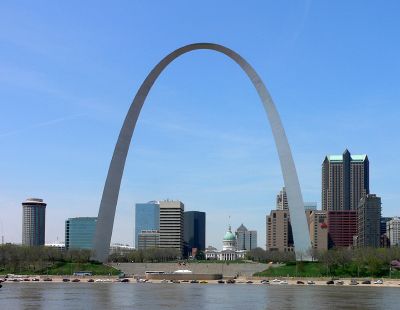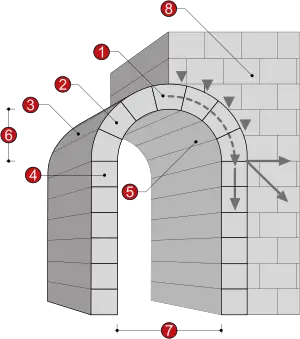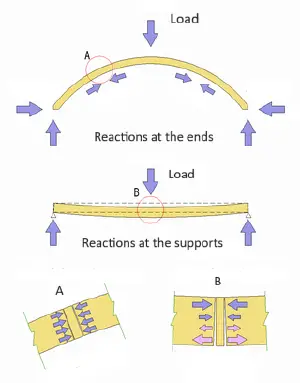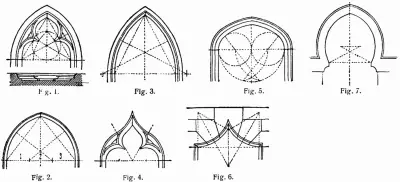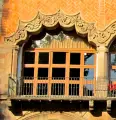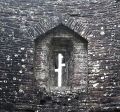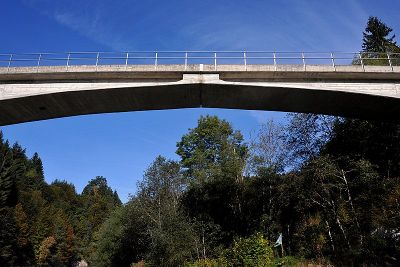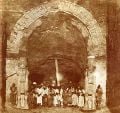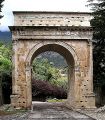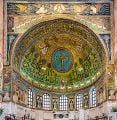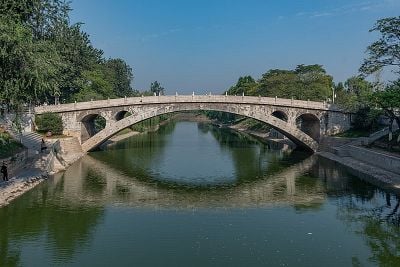Arch
An arch is a curved vertical structure spanning an open space underneath it. An arch can either support the load above it or perform a purely decorative role. The arch dates back to the fourth millennium B.C.E., but became popular only after its adoption by the Romans.
Arches are used as supports for many types of vaults, with the barrel vault in particular being a continuous arch. The arch had several advantages over the lintel, a load-bearing beam (horizontal structural element) that spans openings such as portals, doors, windows, and fireplaces, especially in masonry construction: with the same amount of material it can have larger span, carry more weight, and can be made from smaller and thus more manageable pieces. Their role in construction was diminished in the middle of the nineteenth century with introduction of the wrought iron (and later steel): the high tensile strength of these new materials made long lintels possible.
During the period when arches were commonly used they became much more than functional engineering components, adding beauty to architecture through their form, especially when used in combination and with additional aesthetically pleasing elements.
Basic concepts
Terminology
A true arch is a load-bearing arc with elements held together by compression.[1] The term false arch is usually used to designate an arch that has no structural purpose, like a proscenium arch in theaters used to frame the performance for the spectators, but is also applied to corbelled and triangular arches that are not based on compression.[2]
A typical true masonry arch consists of the following elements[3]:
- Keystone, the top block in an arch. Portion of the arch around the keystone (including the keystone itself), with no precisely defined boundary, is called a crown
- Voussoir (a wedge-like construction block). A rowlock arch is formed by multiple concentric layers of voussoirs.
- Extrados (an external surface of the arch)
- Impost is block at the base of the arch (the voussoir immediately above the impost is a springer). The tops of imposts define the springing level. A portion of the arch between the springing level and the crown (centered around the 45° angle) is called a haunch. If the arch resides on top of a column, the impost is formed by an abacus or its thicker version, dosseret.
- Intrados (an underside of the arch, also known as a soffit)
- Rise (height of the arc, distance from the springing level to the crown)
- Clear span
- Abutment The triangular-shaped portion of the wall between the extrados and the horizontal division above is called spandrel.
Arch action
A true arch, due to its rise, resolves the vertical loads into horizontal and vertical reactions at the ends, a so called arch action. The vertical load produces a positive bending moment in the arch, while the inward-directed horizontal reaction from the spandrel/abutment provides a counterbalancing negative moment. As a result, the bending moment in any segment of the arch is much smaller than in a beam with the equivalent load and span. The diagram on the right shows the difference between a loaded arch and a beam. Elements of the arch are mostly subject to compression (A), while in the beam a bending moment is present, with compression at the top and tension at the bottom (B).
In the past, when arches were made of masonry pieces, the horizontal forces at the ends of an arch caused the need for heavy abutments. The other way to counteract the forces, and thus allow thinner supports, was to use the counter-arches, as in an arcade arrangement, where the horizontal thrust of each arch is counterbalanced by its neighbors, and only the end arches need to buttressed. With new construction materials (steel, concrete, engineered wood), not only the arches themselves got lighter, but the horizontal thrust can be further relieved by a tie connecting the ends of an arch.
Funicular shapes
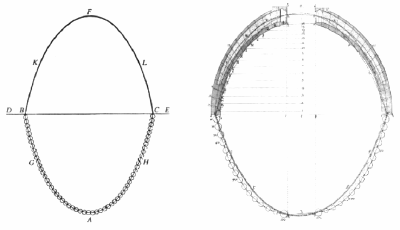
When evaluated from the perspective of an amount of material required to support a given load, the best solid structures are compression-only; with flexible materials the same is true for tension-only designs. There is a fundamental symmetry in nature between solid compression-only and flexible tension-only arrangements, noticed by Robert Hooke in 1676: "As hangs the flexible line, so but inverted will stand the rigid arch." Thus the study (and terminology) of arch shapes is inextricably linked to the study of hanging chain; the corresponding curves or polygons are called funicular. Just like the shape of a hanging chain will vary depending on the weights attached to it, the shape of an ideal (compression-only) arch will depend on the distribution of the load.[4]
Construction

As a pure compression form, the utility of the arch is due to many building materials, including stone and unreinforced concrete, being strong under compression, but brittle when tensile stress is applied to them.[5]
An arch is held in place by the weight of all of its members, making construction problematic. One answer is to build a frame (historically, of wood) which exactly follows the form of the underside of the arch. This is known as a center or centering. Voussoirs are laid on it until the arch is complete and self-supporting. The voussoirs can be wedge-shaped or have a form of a rectangular cuboid, in the latter case the wedge-like shape is provided by the mortar. For an arch higher than head height, scaffolding would be required, so it could be combined with the arch support.
Old arches sometimes need reinforcement due to decay of the keystones, forming what is known as bald arch.
In reinforced concrete construction, the principle of the arch is used so as to benefit from the concrete's strength in resisting compressive stress. Where any other form of stress is raised, such as tensile or torsional stress, it has to be resisted by carefully placed reinforcement rods or fibres.[6]
Structurally, the relieving arches (often blind or containing) can be used to take off load from some portions of the building (for example, to allow use of thinner exterior walls with larger window openings, or, like in Roman Pantheon, to redirect the weight of the upper structures to particular strong points).
Transverse arches, introduced in Carolingian architecture, are placed across the nave to compartmentalize (together with longitudinal separating arches) the internal space into bays and support vaults. Diaphragm arch similarly goes in the transverse direction, but carries a section of wall on top. It is used to support or divide sections of the high roof. The strainer arches were built as an afterthought to prevent two adjacent supports from imploding due to miscalculation. Frequently they were made very decorative, with one of the best examples provided by the Wells Cathedral. Strainer arches can be "inverted" (upside-down) while remaining structural. A counter-arch is built adjacent to another arch to oppose its horizontal action or help to stabilize it, for example, when constructing a flying buttress.[7]
Classifications
There are multiple ways to classify an arch:[8]
- by the geometrical shape of its intrados (for example, semicircular, triangular, etc.)
- for the round arches, by the number of circle segments forming the arch (for example, round arch is single-centred, pointed arch is two-centred)
- by the material used (stone, brick, concrete, steel) and construction approach. For example, the wedge-shaped voussoirs of a brick arch can be made by cutting the regular bricks ("axed brick" arch) or manufactured in the wedge shape ("gauged brick" arch)
- structurally, by the number of hinges (movable joints) between solid components. For example, voussoirs in a stone arch should not move, so these arches usually have no hinges (are "fixed"). Permitting some movement in a large structure allows to alleviate stresses (caused, for example, by the thermal expansion), so many bridge spans are build with three hinges (one at each support and one at the crown) since the mid-nineteenth century.[9]
Arrangements
A sequence of arches can be grouped together forming an arcade.[10] Romans perfected this form, as shown, for example, by arched structures of Pont du Gard. In the interior of hall churches, arcades of separating arches were used to separate the nave of a church from the side aisle, or two adjacent side aisles.
Two-tiered arches, with two arches superimposed, were sometimes used in Islamic architecture, mostly for decorative purposes.
An opening of the arch can be filled, creating a blind arch. Blind arches are frequently decorative, and were extensively used in Early Christian, Romanesque, and Islamic architecture. Alternatively, the opening can be filled with smaller arches, producing a containing arch, common in Gothic and Romanesque architecture. Multiple arches can be superimposed with an offset, creating an interlaced series of usually (with some exceptions) blind and decorative arches. Most likely of Islamic origin, the interlaced arcades were popular in Romanesque and Gothic architecture. Rear-arch (also rere-arch) is the one that frames the internal side of an opening in the external wall.
Shapes
The large variety of arch shapes can be classified into three broad categories: rounded, pointed, and parabolic.[11]
Rounded
"Round" semicircular arches were commonly used for ancient arches that were constructed of heavy masonry,[11] and were relied heavily on by the Roman builders since the fourth century B.C.E. It is considered to be the most common arch form, characteristic for Roman, Romanesque, and Renaissance architecture.
A segmental arch, with a rounded shape that is less than a semicircle, is very old (the versions were cut in the rock in Ancient Egypt c. 2100 B.C.E. at Beni Hasan). Since then it was occasionally used in Greek temples, utilized in Roman residential construction, Islamic architecture, and got popular as window pediments during the Renaissance.
A basket arch (also known as depressed arch, chop arch, three-centered arch, basket handle arch) consists of segments of three circles with origins at three different centers (sometimes five or seven segments). Was used in late Gothic and Baroque architecture.
A horseshoe arch (also known as keyhole arch) has a rounded shape that includes more than a semicircle, is associated with Islamic architecture and was known in areas of Europe with Islamic influence (Spain, Southern France, Italy). Occasionally used in Gothics, it briefly enjoyed popularity as the entrance door treatment in the interwar England.
Semi-circular arches using brick and/or stone block construction at the Great Wall, China
Pointed
A pointed arch consists of two ("two-centred arch") or more circle segments culminating in a point at the top. It originated in Islamic architecture, arrived in Europe in the second half of the eleventh century (Cluny Abbey), and later became prominent in the Gothic architecture.[12] The advantages of a pointed arch over a semicircular one are flexible ratio of span to rise and lower horizontal reaction at the base. This innovation allowed for taller and more closely spaced openings, which are typical of Gothic architecture.[13]
The equilateral arch is the most common form of the pointed arch, with the centers of two circles forming the intrados coinciding with the springing points of the opposite segment. Together with the apex point, they form a equilateral triangle, thus the name. If the centers of circles are farther apart, the arch becomes a narrower and sharper lancet arch that appeared in France in the Early Gothic architecture (Saint-Denis Abbey) and became prominent in England in the late twelfth and early thirteenth centuries (Salisbury Cathedral). If the centers are closer to another, the result is a wider blunt arch.
The intrados of the cusped arch (also known as multifoil arch, polyfoil arch, polylobed arch, and scalloped arch) includes several independent circle segments in a scalloped arrangement. These primarily decorative arches are common in Islamic architecture and Northern European Late Gothic, can be found in Romanesque architecture. A similar trefoil arch includes only three segments and sometimes has a rounded, not pointed, top. Common in Islamic architecture and Romanesque buildings influenced by it, it later became popular in the decorative motifs of the Late Gothic designs of Northern Europe.
Each arc of an ogee arch consists of at least two circle segments (for a total of at least four), with the center of an upper circle being outside the extrados. After European appearance in the thirteenth century on the facade of the St Mark's Basilica, the arch became a fixture of the English Decorated style, French Flamboyant, Venetian, and other Late Gothic styles. The ogee arch is also known as reversed curve arch, occasionally also called an inverted arch. The top of an ogee arch sometimes projects beyond the wall, forming the so-called nodding ogee popular in fourteenth century England (pulpitum in Southwell Minster).
Each arc of a four-centred arch is made of two circle segments with distinct centers; usually the radius used closer to the springing point is smaller with a more pronounced curvature. Common in Islamic architecture (Persian arch), and, with upper portion flattened almost to straight lines (Tudor arch), in the English Perpendicular Gothic. A keel arch is a variant of four-centered arch with haunches almost straight, resembling a section view of a capsized ship. Popular in Islamic architecture, it can be also found in Europe, occasionally with a small ogee element at the top, so it is sometimes considered to be a variation of an ogee arch.[7]
Curtain arch (also known as inflexed arch, and, like the keel arch, usually decorative uses two (or more) drooping curves that join at the apex. Utilized as a dressing for windows and doors primarily in Saxony in the Late Gothic and early Renaissance buildings (late fifteenth to early sixteenth century), associated with Arnold von Westfalen. When the intrados has multiple concave segments, the arch is also called a draped arch or tented arch.[14] A similar arch that uses a mixture of curved and straight segments or exhibits sharp turns between segments is a mixed-line arch.
Parabolic
The popularity of the arches using segments of a circle is due to simplicity of layout and construction, not their structural properties. Consequently, the architects historically used a variety of other curves in their designs: elliptical curves, hyperbolic cosine curves (including catenary), and parabolic curves. There are two reasons behind the selection of these curves:
- they are still relatively easy to trace with common tools prior to construction;
- depending on a situation, they can have superior structural properties and/or appearance.
The hyperbolic curve is not easy to trace, but there are known cases of its use. The non-circumferential curves look similar, and match at shallow profiles, so a catenary is often misclassified as a parabola[15] (per Galileo, "the [hanging] chain fits its parabola almost perfectly"). Researchers do not agree on classification of the arches or claim the prominence of parabolic arches, while the measurements show that just two of the 23 arches of Palau Güell, designed by Gaudi, are actually parabolic.
Three parabolic-looking curves in particular are of significance to the arch design: parabola itself, catenary, and weighted catenary. The arches naturally use the inverted (upside-down) versions of these curves.
A parabola represents an ideal (all-compression) shape when the load is equally distributed along the span, while the weight of the arch itself is negligible. A catenary is the best solution for the case where an arch with uniform thickness carries just its own weight with no external load. The practical designs for bridges are somewhere in between, and thus use the curves that represent a compromise that combines both the catenary and the funicular curve for particular non-uniform distribution of load.[16] The practical free-standing arches are stronger and thus heavier at the bottom, so a weighted catenary curve is utilized for them. The same curve also fits well an application where a bridge consists of an arch with a roadway of packed dirt above it, as the dead load increases with a distance from the center.
A through arch bridge (Tyne Bridge in Newcastle upon Tyne, England): parabolic-looking arches with multiple deck supports distributing the load
Other
Unlike regular arches, the flat arch (also known as jack arch, lintel arch, straight arch, plate-bande[17]) is not curved. Instead, the arch is flat in profile and can be used under the same circumstances as lintel. However, lintels are subject to bending stress, while the flat arches are true arches, composed of irregular voussoir shapes (the keystone is the only one of the symmetric wedge shape), and that efficiently uses the compressive strength of the masonry in the same manner as a curved arch and thus requires a mass of masonry on both sides to absorb the considerable lateral thrust. Used in the Roman architecture to imitate the Greek lintels, Islamic architecture, European medieval, and Renaissance architecture. The flat arch is still being used as a decorative pattern, primarily at the top of window openings.
False arches
The corbel (also corbelled) arch, made of two corbels meeting in the middle of the span, is a true arch in a sense of being able to carry a load, but it is false in a structural sense, as its components are subject to bending stress. The typical profile is not curved, but has triangular shape. Invented prior to the semicircular arch, the corbel arch was used already in the Egyptian and Mycenaean architecture in the third millennium B.C.E. and second millennium B.C.E.
Like a corbel arch, the triangular arch is not a true arch in a structural sense. Its intrados is formed by two slabs leaning against each other. Brick builders would call triangular any arch with straight inclined sides. The design was common in Anglo-Saxon England until the late eleventh century (St Mary Goslany). Mayan corbel arches are sometimes called triangular due to their shape.
Variations
Few transformations can be applied to arch shapes.
If one impost is much higher than another, the arch (frequently pointed) is known as Arc rampant (ramping arch), raking arch,[18] or rampant arch. Originally used to support inclined structures, like staircases, in the thirteenth-fourteenth centuries their appeared as parts of flying buttresses used to counteract the thrust of Gothic ribbed vaults.
A central part of an arch can be raised on short vertical supports, creating a trefoil-like shouldered arch. The raised central part can vary all the way from a flat arch to ogee. The shouldered arches were used to decorate openings in Europe from medieval times to Late Gothic architecture, became common in Iranian architecture from the fourteenth century, and were later adopted in the Ottoman Turkey.
In a stilted arch (also surmounted), the springing line is located above the imposts (on "stilts"). Known to Islamic architects by the eighth century, the technique was utilized to vertically align the apexes of arches of different dimensions in Romanesque and Gothic architecture. Stilting was useful for semicircular arches, where the ratio of the rise fixed at 1⁄2 of the span, but was applied to the pointed arches, too.
The skew arch (also known as an oblique arch) is used when the arch needs to turn in the horizontal plane, for example, when a bridge crosses the river at an angle different than 90°. A splayed arch is used for the case of unequal spans on the sides of the arch (when, for example, an interior opening in the wall is larger than the exterior one), the intrados of a round splayed arch is not cylindrical, but has a conical shape.[19]
Shouldered arch above the main entrance of Doge's Palace in Venice. The vertical supports separate the segments of an ogee arch.
A wide arch with its rise less than 1⁄2 of the span (and thus the geometric circle of at least one segment is below the springing line) is called a surbased arch (sometimes also a depressed arch). A drop arch is either a basket handle arch or a blunt arch.
Hinged arches
The practical arch bridges are built either as a fixed arch, a two-hinged arch, or a three-hinged arch.[20] The fixed arch is most often used in reinforced concrete bridges and tunnels, which have short spans. Because it is subject to additional internal stress from thermal expansion and contraction, this kind of arch is statically indeterminate (the internal state is impossible to determine based on the external forces alone).[11]
The two-hinged arch is most often used to bridge long spans.[11] This kind of arch has pinned connections at its base. Unlike that of the fixed arch, the pinned base can rotate, thus allowing the structure to move freely and compensate for the thermal expansion and contraction that changes in outdoor temperature cause. However, this can result in additional stresses, and therefore the two-hinged arch is also statically indeterminate, although not as much as the fixed arch.[11]
The three-hinged arch is not only hinged at its base, like the two-hinged arch, yet also at its apex. The additional apical connection allows the three-hinged arch to move in two opposite directions and compensate for any expansion and contraction. This kind of arch is thus not subject to additional stress from thermal change. Unlike the other two kinds of arch, the three-hinged arch is therefore statically determinate.[20] It is most often used for spans of medial length, such as those of roofs of large buildings. Another advantage of the three-hinged arch is that the reaction of the pinned bases is more predictable than the one for the fixed arch, allowing shallow, bearing-type foundations in spans of medial length. In the three-hinged arch "thermal expansion and contraction of the arch will cause vertical movements at the peak pin joint but will have no appreciable effect on the bases," which further simplifies foundational design.[11]
History
The arch became popular in the Roman times and spread alongside European influence, although it was known and used much earlier. However, many ancient architectures avoided the use of arches, including the Viking and Hindu architectures.
Ancient Near East
True arches, as opposed to corbel arches, were known by a number of civilizations in the ancient Near East including the Levant, but their use was infrequent and mostly confined to underground structures, such as drains where the problem of lateral thrust is greatly diminished. An example of the latter would be the Nippur arch, built before 3800 B.C.E., possibly even before 4000 B.C.E.[21] Rare exceptions are an arched mudbrick home doorway dated to c. 2000 B.C.E. from Tell Taya in Iraq, and two Bronze Age arched Canaanite city gates, one at Ashkelon (dated to c. 1850 B.C.E.),[22] and one at Tel Dan (dated to c. 1750 B.C.E.), both in modern-day Israel.[23] An Elamite tomb dated 1500 B.C.E. from Haft Teppe contains a parabolic vault which is considered one of the earliest evidences of arches in Iran.
The use of true arches in Egypt also originated in the fourth millennium B.C.E. (underground barrel vaults at the Dendera cemetery). The standing arches were known since at least the Third Dynasty, but very few examples survived, since the arches were mostly used in the non-durable secular buildings and made of mud brick voussoirs that were not wedge-shaped, but simply held in place by mortar, and thus susceptible to a collapse (the oldest arch still standing is at Ramesseum). Sacred buildings exhibited either lintel design or corbelled arches. The arches were mostly missing in Egypt temples even after the Roman conquest, even though Egyptians thought of the arch as a spiritual shape and used it in the rock-cut tombs and portable shrines.
Mycenaean architecture utilized only the corbel arches in their beehive tombs with triangular openings. Mycenaeans had also built probably the oldest still standing stone-arch bridge in the world, Arkadiko Bridge, in Greece.
As evidenced by their imitations of the parabolic arches, Hittites most likely were exposed to the Egyptian designs, but used the corbelled technique to build them.
A true arch (catenary) at the Ramesseum granaries (c. 1300 B.C.E.)
Ruins of the Kazarma tholos tomb (c.1500 B.C.E.) showing the Mycenaean beehive technique
Arkadiko Bridge (c. 1300-1190 B.C.E.): corbel arch, cyclopean masonry
Classical Persia and Greece
The Assyrians, also apparently under the Egyptian influence, adopted the true arch (with a slightly pointed profile) early in the eighth century. In ancient Persia, the Achaemenid Empire (550 B.C.E. – 330 B.C.E.) built small barrel vaults (essentially a series of arches built together to form a hall) known as iwan, which became massive, monumental structures during the later Parthian Empire (247 B.C.E. – 224 C.E.).[24][25] This architectural tradition was continued by the Sasanian Empire (224–651), which built the Taq Kasra at Ctesiphon in the sixth century C.E., the largest free-standing vault until modern times.
An early European example of a voussoir arch appears in the fourth century B.C.E. Greek Rhodes Footbridge. Proto-true arches can also be found under the stairs of the temple of Apollo at Didyma and the stadium at Olympia.
Ancient Rome
The ancient Romans learned the semicircular arch from the Etruscans (both cultures apparently adopted the design in the fourth century B.C.E., refined it and were the first builders in Europe to tap its full potential for above ground buildings:
The Romans were the first builders in Europe, perhaps the first in the world, to fully appreciate the advantages of the arch, the vault and the dome.[26]
Throughout the Roman empire, from Syria to Scotland, engineers erected arch structures. The first use of arches was for civic structures, like drains and city gates. Later the arches were utilized for major civic buildings, bridges, and aqueducts, with the outstanding first century C.E. examples provided by the Colosseum, Pont Du Gard, and the aqueduct of Segovia. The introduction of the ceremonial triumphal arch dates back to Roman republic, although the best examples are from the imperial times (Arch of Augustus at Susa, Arch of Titus).
Romans initially avoided using the arch in the religious buildings and, in Rome, arched temples were quite rare until the recognition of Christianity in 313 C.E. (with the exceptions provided by the Pantheon and the "temple of Minerva Medica"). Away from the capital, arched temples were more common, such as the temple of Hadrian at Ephesus, temple of Jupiter at Sbeitla, and Severan temple at Djemila). The arrival of Christianity prompted creation of the new type of temple, a Christian basilica, that made a thorough break with the pagan tradition with arches as one of the main elements of the design, along with the exposed brick walls (Santa Sabina in Rome, Sant'Apollinare in Classe). For a long period, from the late fifth century to the twentieth century, arcades were a standard staple for the Western Christian architecture.
Vaults began to be used for roofing large interior spaces such as halls and temples, a function that was also assumed by domed structures from the first century B.C.E. onwards.
The segmental arch was first built by the Romans, who realized that an arch in a bridge did not have to be a semicircle,[27] such as in Alconétar Bridge or Ponte San Lorenzo. The utilitarian and mass residential (insulae) buildings, as found in Ostia Antica and Pompeii, mostly used low segmental arches made of bricks and architraves made of wood, while the concrete lintel arches can be found in villas and palaces.
The Jupiter gate at Falerii Novi (c. 300 B.C.E.)
Arch of Augustus, Susa, Piedmont (c. 8 B.C.E.)
Temple of Jupiter at Sbeitla (c. 150 C.E.)
Arches in the narthex of Santa Sabina, Rome (c. 425 C.E.)
Ancient China
Ancient architecture of China (and Japan) used mostly timber-framed construction and trabeated system. Arches were little used, although there are few arch bridges known from literature and one artistic depiction in stone-carved relief.[28][29] Since the only surviving artefacts of architecture from the Han dynasty (202 B.C.E. – 220 C.E.) are rammed earth defensive walls and towers, ceramic roof tiles from no longer existent wooden buildings,[30] stone gate towers,[29] and underground brick tombs, the known vaults, domes, and archways were built with the support of the earth and were not free-standing.[31]
China's oldest surviving stone arch bridge is the Anji Bridge. Still in use, it was built between 595 C.E. and 605 C.E. during the Sui dynasty.[32]
Islamic
Islamic architects adopted the Roman arches, but quickly showed their resourcefulness: by the eighth century the simple semicircular arch was almost entirely replaced with fancier shapes, a few fine examples of the former in the Umayyad architecture notwithstanding (such as the Great Mosque of Damascus, 706–715 C.E.). The first pointed arches appear already at the end of the seventh century C.E. (Al-Aqsa Mosque, Palace of Ukhaidhir, cisterns at the White Mosque of Ramle Their variations spread fast and wide: Mosque of Ibn Tulun in Cairo (876-879 C.E.), Nizamiyya Madrasa at Khar Gerd (now Iran, eleventh century), Kongo Mosque in Diani Beach (Kenya, sixteenth century).
Islamic architecture brought to life a large amount of arch forms: the round horseshoe arch that became a characteristic trait of the Islamic buildings, the keel arch, the cusped arch, and the mixed-line arch (where the curved "ogee swell" is interspersed with abrupt bends). The Great Mosque of Cordoba, that can be considered a catalogue of Islamic arches, contains also the arches with almost straight sides, trefoil, interlaced, and joggled. Mosque of Ibn Tulun adds four-centered and stilted version of the pointed arch.
It is quite likely that the appearance of the pointed arch, an essential element of the Gothic style, in Europe (Monte Cassino, 1066–1071 C.E., and the Cluny Abbey five years later) and the ogee arch in Venice (c. 1250) is a result of the Islamic influence, possibly through Sicily. Islamic architects also spread the transverse arch. Mixed-line arch became popular in the Mudéjar style and subsequently spread around the Spanish-speaking world.
India
The history of the arch in India is very long (some arches were apparently found in excavations of Kosambi, second millennium B.C.E.). However, its history of continuous use begins with rock-cut arches in the Lomas Rishi cave (third century B.C.E.). The vaulted roof of an early Harappan burial chamber has been noted at Rakhigarhi,[33] and a vaulted roof of a small chamber in a house from Lothal.[34] Barrel vaults were also used in the Late Harappan Cemetery H culture dated 1900 B.C.E. - 1300 B.C.E. which formed the roof of the metal working furnace, discovered in 1940 during excavation at Harappa.[35]
The use of arches until the Islamic conquest of India in the twelfth century C.E. was sporadic, with ogee arches and barrel vaults in rock-cut temples (Karla Caves, from the first century B.C.E.) and decorative pointed gavaksha arches. By the fifth century C.E. voussoir vaults were used structurally in the brick construction. Surviving examples include the temple at Bhitargaon (fifth century C.E.) and Mahabodhi temple (seventh century C.E.), the latter has both pointed arches and semicircular arches.[36] These Gupta era systems were later used extensively in Burmese Buddhist temples in Pyu and Bagan in the eleventh and twelfth centuries.[37]
With the arrival of Islamic and other Western Asian influences, the arches became prominent in Indian architecture, although the post and lintel construction was still preferred. A variety of pointed and lobed arches was characteristic of Indo-Islamic architecture, as seen in Buland Darwaza which has pointed arches decorated with small cusped arches.
Decorative ogee arches (gavaksha) in Ajanta Caves
Western Europe
The collapse of the Western Roman Empire left the church as the only client of major construction; with all pre-Romanesque architectural styles borrowing from Roman construction with its semicircular arch. Due to the decline in the construction quality, the walls were thicker, and the arches thus heavier, than their Roman prototypes. Eventually the architects started to use the depth of the arches for decoration, turning the deep opening into an arch order (or rebated arch, a sequence of progressively smaller concentric arches, each inset with a rebate).
Romanesque style started experiments with the pointed arch late in the eleventh century (Cluny Abbey). In few decades, the practice spread (Durham Cathedral, Basilica of Saint-Denis). Early Gothic utilized the flexibility of the pointed arch by grouping together arches of different spans but with the same height.
While the arches used in the medieval Europe were borrowed from the Roman and Islamic architecture, the use of pointed arch to form the rib vault was novel and became the defining characteristic of Gothic construction. At about 1400 C.E., the city-states of Italy, where the pointed arch had never gained much traction, initiated the revival of the Roman style with its round arches, Renaissance. By the sixteenth century the new style spread across Europe and, through the influence of empires, to the rest of the world. The arch became a dominant architectural form until the introduction of new construction materials, like steel and concrete.
Revival of lintels
The nineteenth-century introduction of the wrought iron (and later steel) into construction changed the role of the arch. Due to the high tensile strength of new materials, relatively long lintels became possible, as demonstrated by the tubular Britannia Bridge (Robert Stephenson, 1846-1850). The use of arches in bridge construction continued (the Britannia Bridge was rebuilt in 1972 as a truss arch bridge), yet the steel frames and reinforced concrete frames mostly replaced the arches as the load-bearing elements in buildings.
Notes
- ↑ Michael Clarke, The Concise Dictionary of Art Terms (Oxford University Press, 2010, ISBN 978-0199569922).
- ↑ Christopher Gorse, David Johnston, and Martin Pritchard (eds.), A Dictionary of Construction, Surveying and Civil Engineering (Oxford University Press, 2020, ISBN 978-0198832485).
- ↑ Christine Beall, Masonry Design and Detailing: For Architects, Engineers, and Builders (McGraw-Hill Companies, 1987, ISBN 978-0070042230).
- ↑ Mark West, The Fabric Formwork Book: Methods for Building New Architectural and Structural Forms in Concrete (Routledge, 2016, ISBN 0415748860).
- ↑ Esmond Reid, Understanding Buildings: A Multidisciplinary Approach (Routledge, 2016, ISBN 978-1138836914).
- ↑ Edward Allen and Joseph Iano, Fundamentals of Building Construction (Wiley, 2019, ISBN 978-1119446194).
- ↑ 7.0 7.1 James Stevens Curl, A Dictionary of Architecture and Landscape Architecture (Oxford University Press, 2007, ISBN 978-0198606789).
- ↑ B.C. Punmia, Ashok Kumar Jain, and Arun Kumar Jain, Building Construction (Laxmi Publications, 2005, ISBN 978-8170080534).
- ↑ Paulo J. Cruz (ed.), Structures and Architecture: New concepts, applications and challenges (CRC Press, 2013, ISBN 978-0415661959).
- ↑ James Bettley and Nikolaus Pevsner, Essex: The buildings of England (Yale University Press, 1994, ISBN 978-0300116144).
- ↑ 11.0 11.1 11.2 11.3 11.4 11.5 James Ambrose and Patrick Tripeny, Building Structures (Wiley, 2011, ISBN 978-0470542606).
- ↑ Paul Frankl and Paul Crossley, Gothic Architecture (Yale University Press, 2001, ISBN 978-0300087994).
- ↑ Ahmet Hadrovic, Structural Systems in Architecture (BookSurge Publishing, 2009, ISBN 978-1439259443).
- ↑ Nikolas Davies and Erkki Jokiniemi, Architect's Illustrated Pocket Dictionary (Routledge, 2010, ISBN 978-0080965376).
- ↑ Alphose Zingoni (ed.), Current Perspectives and New Directions in Mechanics, Modelling and Design of Structural Systems (CRC Press, 2022, ISBN 978-1032391144).
- ↑ Robert Benaim, The Design of Prestressed Concrete Bridges: Concepts and Principles (CRC Press, 2019, ISBN 978-0367865726).
- ↑ Dennis Hart Mahan, A Treatise on Civil Engineering (Legare Street Press, 2022 (original 1873), ISBN 978-1017337143).
- ↑ Nikolas Davies and Erkki Jokiniemi, Dictionary of Architecture and Building Construction (Routledge, 2008, ISBN 978-0750685023).
- ↑ José Calvo-López, Stereotomy: Stone Construction and Geometry in Western Europe 1200–1900 (Birkhäuser, 2020, ISBN 978-3030432171).
- ↑ 20.0 20.1 Charles E. Reynolds, James C. Steedman, and Anthony J. Threlfall, Reinforced Concrete Designer's Handbook (CRC Press, 2007, ISBN 978-0419258209).
- ↑ Babylonia New Schaff-Herzog Encyclopedia of Religious Knowledge. Retrieved March 18, 2024.
- ↑ Etgar Lefkovits, Oldest arched gate in the world restored The Jerusalem Post (April 8, 2008). Retrieved March 18, 2024.
- ↑ Israel Finkelstein, The Quest for the Historical Israel (Society of Biblical Literature, 2007, ISBN 978-1589832770).
- ↑ Maria Brosius, The Persians: An Introduction (Routledge, 2006, ISBN 978-0415320900).
- ↑ Gene R. Garthwaite, The Persians (Wiley-Blackwell, 2006, ISBN 978-1405156806).
- ↑ Donald S. Robertson, Greek and Roman Architecture (Cambridge University Press, 1969, ISBN 978-0521094528).
- ↑ Colin O'Connor, Roman Bridges (Cambridge University Press, 1994, ISBN 978-0521393263).
- ↑ Joseph Needham, Science and Civilisation in China: Volume 4, Physics and Physical Technology; Part 2, Mechanical Engineering (Cambridge University Press, 1965, ISBN 978-0521058032).
- ↑ 29.0 29.1 Nancy Steinhardt, Chinese Architecture (Princeton University Press, 2019, ISBN 978-0691169989).
- ↑ W. Scott Morton and Charlton M. Lewis, China: Its History and Culture (McGraw Hill, 2004, ISBN 978-0071412797).
- ↑ William Watson, The Arts of China to A.D. 900 (Yale University Press, 1995, ISBN 978-0300059892).
- ↑ Ronald G. Knapp, Chinese Bridges: Living Architecture From China's Past (Tuttle Publishing, 2008, ISBN 978-0804838849).
- ↑ Jane R. McIntosh, The Ancient Indus Valley: New Perspectives (ABC-CLIO, 2007, ISBN 978-1576079072).
- ↑ Shikaripur Ranganatha Rao, Lothal and the Indus Civilization (Asia Publishing House, 1973, ISBN 978-0210222782).
- ↑ George F. Dales and Jonathan Mark Kenoyer, Summaries of Five Seasons of Research at Harappa (Harappa, 1995). Retrieved March 18, 2024.
- ↑ Daigoro Chihara, Hindu-Buddhist Architecture in Southeast Asia (Brill Academic Pub, 1996, ISBN 978-9004105126).
- ↑ Le Huu Phuoc, Buddhist Architecture (Grafikol, 2010, ISBN 978-0984404308).
ReferencesISBN links support NWE through referral fees
- Allen, Edward, and Joseph Iano. Fundamentals of Building Construction. Wiley, 2019. ISBN 978-1119446194
- Ambrose, James, and Patrick Tripeny. Building Structures. Wiley, 2011. ISBN 978-0470542606
- Beall, Christine. Masonry Design and Detailing: For Architects, Engineers, and Builders. McGraw-Hill Companies, 1987. ISBN 978-0070042230
- Benaim, Robert. The Design of Prestressed Concrete Bridges: Concepts and Principles. CRC Press, 2019. ISBN 978-0367865726
- Bettley, James, and Nikolaus Pevsner. Essex: The buildings of England. Yale University Press, 1994. ISBN 978-0300116144
- Brosius, Maria. The Persians: An Introduction. Routledge, 2006. ISBN 978-0415320900
- Calvo-López, José. Stereotomy: Stone Construction and Geometry in Western Europe 1200–1900. Birkhäuser, 2020. ISBN 978-3030432171
- Chihara, Daigoro. Hindu-Buddhist Architecture in Southeast Asia. Brill Academic Pub, 1996. ISBN 978-9004105126
- Clarke, Michael. The Concise Dictionary of Art Terms. Oxford University Press, 2010. ISBN 978-0199569922
- Cruz, Paulo J. (ed.). Structures and Architecture: New concepts, applications and challenges. CRC Press, 2013. ISBN 978-0415661959
- Curl, James Stevens. A Dictionary of Architecture and Landscape Architecture. Oxford University Press, 2007. ISBN 978-0198606789
- Davies, Nikolas, and Erkki Jokiniemi. Dictionary of Architecture and Building Construction. Routledge, 2008. ISBN 978-0750685023
- Davies, Nikolas, and Erkki Jokiniemi. Architect's Illustrated Pocket Dictionary. Routledge, 2010. ISBN 978-0080965376
- Finkelstein, Israel. The Quest for the Historical Israel. Society of Biblical Literature, 2007., ISBN 978-1589832770
- Garthwaite, Gene R. The Persians. Wiley-Blackwell, 2006. ISBN 978-1405156806
- Gorse, Christopher, David Johnston, and Martin Pritchard (eds.). A Dictionary of Construction, Surveying and Civil Engineering. Oxford University Press, 2020. ISBN 978-0198832485
- Hadrovic, Ahmet. Structural Systems in Architecture. BookSurge Publishing, 2009. ISBN 978-1439259443
- Knapp, Ronald G. Chinese Bridges: Living Architecture From China's Past. Tuttle Publishing, 2008. ISBN 978-0804838849
- Mahan, Dennis Hart. A Treatise on Civil Engineering. Legare Street Press, 2022 (original 1873). ISBN 978-1017337143
- McIntosh, Jane R. The Ancient Indus Valley: New Perspectives. ABC-CLIO, 2007. ISBN 978-1576079072
- Morton, W. Scott, and Charlton M. Lewis. China: Its History and Culture. McGraw Hill, 2004. ISBN 978-0071412797
- Needham, Joseph. Science and Civilisation in China: Volume 4, Physics and Physical Technology; Part 2, Mechanical Engineering. Cambridge University Press, 1965. ISBN 978-0521058032
- O'Connor, Colin. Roman Bridges. Cambridge University Press, 1994. ISBN 978-0521393263
- Phuoc, Le Huu. Buddhist Architecture. Grafikol, 2010. ISBN 978-0984404308
- Punmia, B.C., Ashok Kumar Jain, and Arun Kumar Jain. Building Construction. Laxmi Publications, 2005. ISBN 978-8170080534
- Rao, Shikaripur Ranganatha. Lothal and the Indus Civilization. Asia Publishing House, 1973. ISBN 978-0210222782
- Reid, Esmond. Understanding Buildings: A Multidisciplinary Approach. Routledge, 2016. ISBN 978-1138836914
- Reynolds, Charles E., James C. Steedman, and Anthony J. Threlfall. Reinforced Concrete Designer's Handbook. CRC Press, 2007. ISBN 978-0419258209
- Robertson, Donald S. Greek and Roman Architecture. Cambridge University Press, 1969. ISBN 978-0521094528
- Steinhardt, Nancy. Chinese Architecture. Princeton University Press, 2019. ISBN 978-0691169989
- Watson, William. The Arts of China to A.D. 900. Yale University Press, 1995. ISBN 978-0300059892
- West, Mark. The Fabric Formwork Book: Methods for Building New Architectural and Structural Forms in Concrete. Routledge, 2016. ISBN 0415748860
- Zingoni, Alphose (ed.). Current Perspectives and New Directions in Mechanics, Modelling and Design of Structural Systems. CRC Press, 2022. ISBN 978-1032391144
External links
All links retrieved March 18, 2024.
- Physics of Stone Arches by Melissa Salpietra, PBS.
- InteractiveTHRUST Massachusetts Institute of Technology.
- The History of Architecture in Eleven Arches by Leah Sinclair, The Architectural Review (December 19, 2014).
Credits
New World Encyclopedia writers and editors rewrote and completed the Wikipedia article in accordance with New World Encyclopedia standards. This article abides by terms of the Creative Commons CC-by-sa 3.0 License (CC-by-sa), which may be used and disseminated with proper attribution. Credit is due under the terms of this license that can reference both the New World Encyclopedia contributors and the selfless volunteer contributors of the Wikimedia Foundation. To cite this article click here for a list of acceptable citing formats.The history of earlier contributions by wikipedians is accessible to researchers here:
The history of this article since it was imported to New World Encyclopedia:
Note: Some restrictions may apply to use of individual images which are separately licensed.
